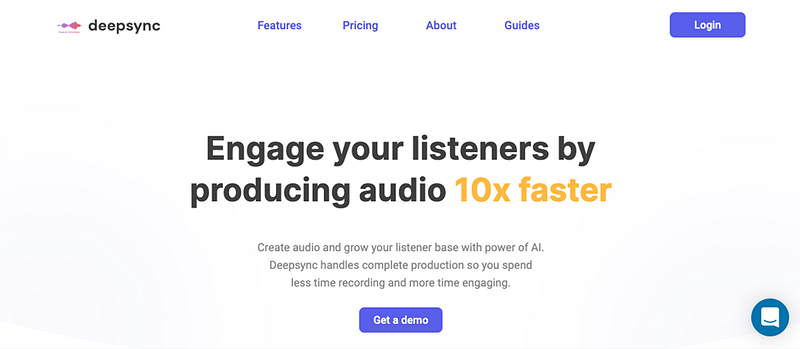And utilizing the correct vocabulary, imagery, and punctuation will enable you to control how your readers feel.
All of these methods indeed help craft personable pieces, but everyone is doing this as everyone is now driven to produce written content that is extremely SEO optimized.
With so many websites focused on writing engaging content, don't you think there's more that can be done to improve the engagement experience?
And a way to stand out from your competition?
What if you could get your written content narrated in a voice that is recognizable to your audience for example using your natural voice to engage your audience through a high-quality audio voice-over?
It must be confusing to you what we are talking about. What would be the point of recording each and every piece of content in your voice, spending hours in the recording studio, and paying $80 to $200 to get 4–5 hours of studio-quality audio in your voice?
While you can just use the TTS service and provide voice-over? But do you really feel TTS-generated voice will enhance your user experience as we all know they sound super robotic?
Well, what if we told you that you won't have to go through any recording and still be able to provide voice-over in your content, in your voice that will sound exactly like you and not a mini robot version of you, without even speaking a word.
Yes, this can be achieved with your cloned voice that includes your tone and accent. Find out more about voice cloning and the best tool we have come across recently, which is available for both individuals and enterprises.
What is Voice Cloning?
Artificially stimulating a person's voice is known as voice cloning. The AI software methods of today allow the creation of synthetic speech that is very similar to a natural human voice. It is sometimes difficult for the average person to tell the difference between the original voice and the AI-cloned voice.
With the advancements in Artificial Intelligence and Deep Learning, synthetic speech is becoming more accurate and sounds like something spoken by a real person.
In the past few years, synthetic speech has been introduced to the public through a variety of voice interaction systems, such as Amazon Alexa, Siri, and countless other voice interface technologies.
Why Do You Need To Have AI Voice Over for Your Blogs?
- Make the site more accessible: Make your blogs/guides more accessible and engaging by incorporating high-fidelity AI voice-over. Simply loading an article and pressing a play will be extremely beneficial for visually impaired readers as well as for people who are driving to work and looking to gain some knowledge and can easily listen to your guide and blog in your natural-sounding AI voice.
- Engage users at a higher level: A static page with high-quality audio content can receive 10x more engagement. Content that is captivating and entertaining will make the message stand out and be more likely to catch the attention of the target audience.
- A convenient method of obtaining information: More than six in ten audio content consumers consume content while doing something else. Listening to an article while doing other things is the most convenient option for readers when they don't have time to sit down and scroll through an article.
- Improves revenue generation: Improves revenue generation: Creating a unique audio advertisement can generate revenue. Make money by monetizing the ad space above the audio player, which displays a "Sponsored By" text and logo linking the audience to your website.
- Ensure you receive the undivided attention of your audience: Audio provides an immersive and emotional experience, so whenever a user listens to you, it's all about them and you as you have all their attention focussed on your messaging.
iHeart Media conducted an audio research study that found audio can have a significant effect on a brand's perception. Additionally, it can contribute to the reputation of organizations and individuals.
Blogs and Guides Voice Over with Deepsync
This is a sample of their YouTube video where you can hear how well they cloned human voices in both English and Hindi language.
You can also watch it in the Hindi language.
Besides cloning your voice, their platform also has an inbuilt studio feature that lets you edit, mix-match, and add background music to your AI audio to create professional audio content in minutes that sounds like it came straight from an expensive recording studio. Saving time and cost at the same time.
Individual creators can get audio recorded for a much lower price than at a professional studio. Also, they have plans for large enterprises.
Getting your voice cloned with Deepsync allows you to create:
- Podcasts
- YouTube videos
- Dynamic Ads
- Email audio integration
According to our study of their use case guides, which you can access here, the above use case data has been provided to you.
There are a lot of other alternatives for AI voice over but Deepsync stands out in providing a natural voice experience that is unmatchable to its competitors.
Conclusion
Whether you are blogging, podcasting, or engaging on social media, Deepsync has you covered!
As far as engagement goes, you're two steps ahead of your competitors with the best pricing and a natural-sounding replicated AI voice.
You can also check our AI voice generator recommendations for more options to explore for creating an AI voice for your blog posts.
Please Note: This is a guest post on How to create an AI Voice for your blog posts by Aryan Shukla from Deepsync on the Digital People website, Learn more about the Digital people guest posts policy by following the link.


Post a Comment